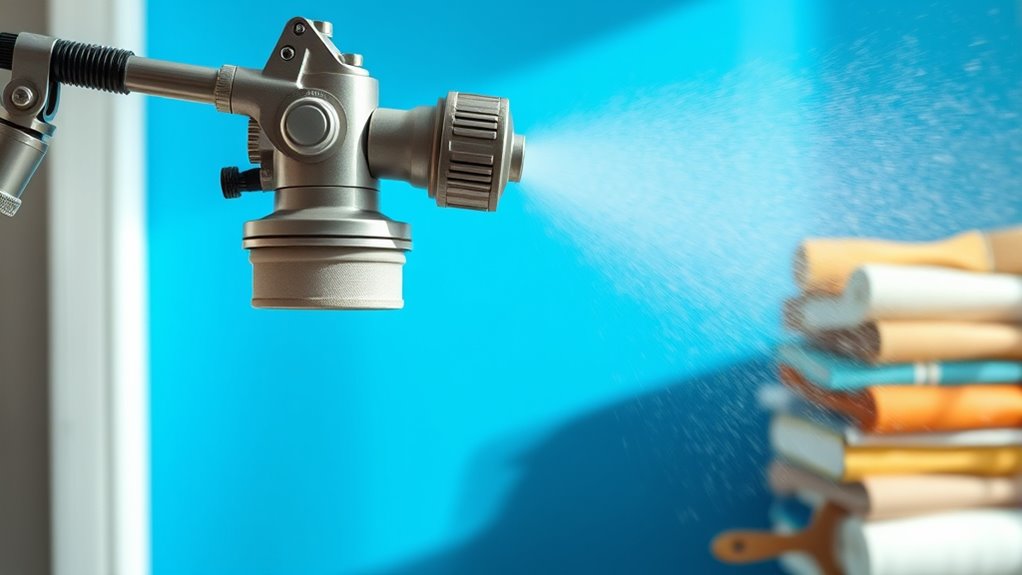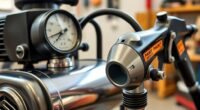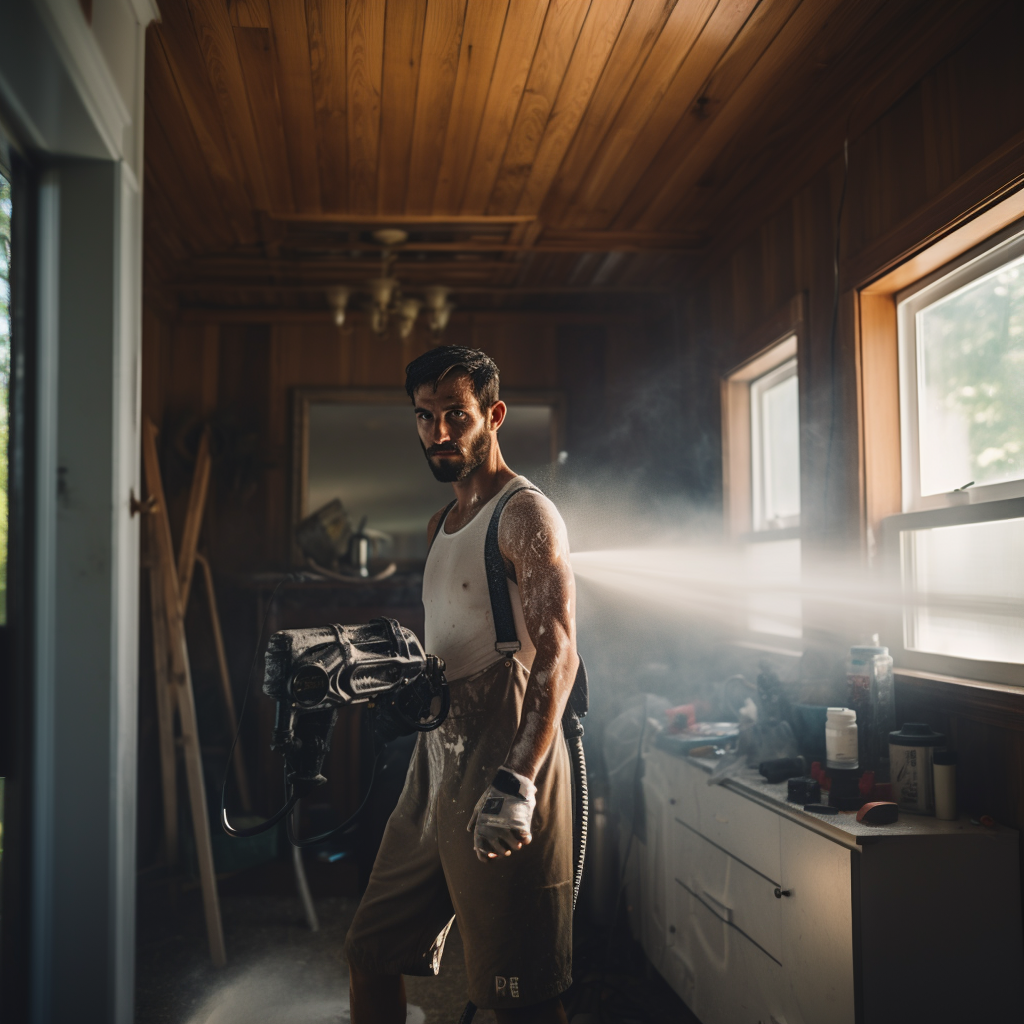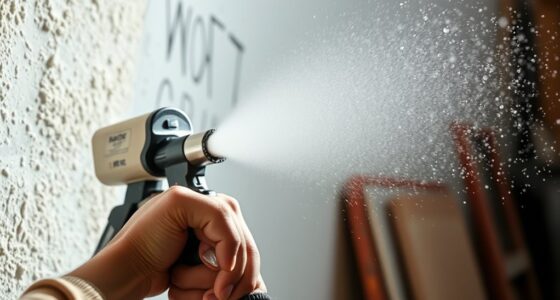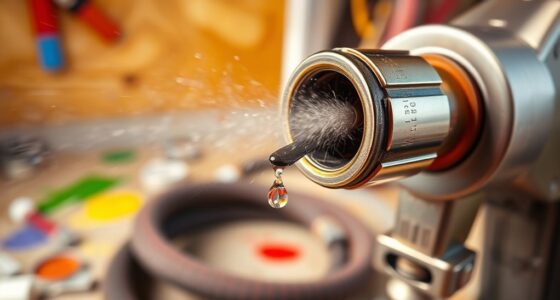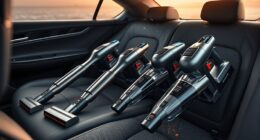Paint sprayers often use more paint than brushes or rollers because their spray method produces overspray and material loss, especially on large surfaces. While sprayers cover areas faster and provide smooth finishes, they can waste paint if not used properly. Brushes and rollers are more precise and typically consume less paint per area. If you want to learn effective techniques to minimize waste and choose the best tool for your project, keep exploring.
Key Takeaways
- Paint sprayers often produce overspray, leading to higher paint consumption compared to brushes or rollers.
- Proper technique and equipment adjustments can minimize waste, but sprayers typically use more paint overall.
- Brushes and rollers deliver more precise application with less overspray, reducing paint usage.
- Sprayers cover large areas quickly but tend to waste more paint due to overspray and evaporation.
- The actual paint used depends on surface type, project size, and technique, with sprayers generally using more paint in practice.
How Paint Sprayers Dispense Paint Compared to Brushes and Rollers
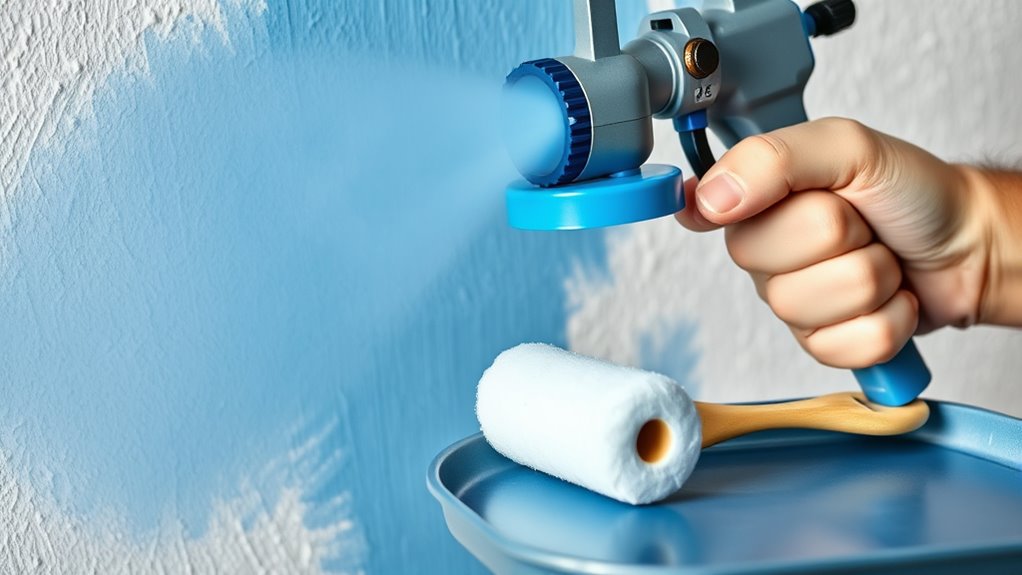
Paint sprayers dispense paint by atomizing it into a fine mist, allowing for quick and even coverage over large surfaces. This process relies heavily on paint viscosity; thinner paints spray more smoothly, creating a consistent spray pattern. If the paint is too thick, it may clog the nozzle or result in uneven application. The spray pattern produced by a sprayer can be adjusted to suit different surfaces and project sizes, offering versatility that brushes and rollers lack. Unlike brushes, which apply paint in strokes, or rollers, which roll paint onto surfaces, sprayers deliver paint directly in a controlled, fine spray. This method can lead to excess paint use, especially if the spray pattern isn’t properly adjusted or the paint viscosity isn’t *ideal*. Additionally, spray technique and proper maintenance of the equipment can significantly influence the amount of paint used during a project. Proper paint flow control ensures that paint is dispensed efficiently, reducing waste and overuse. Adjusting the spray pattern can also help control paint flow and reduce waste. Using the correct nozzle size can also help control paint flow and reduce waste, and selecting the appropriate nozzle type can further optimize paint atomization.
Factors Affecting Paint Usage in Different Application Methods
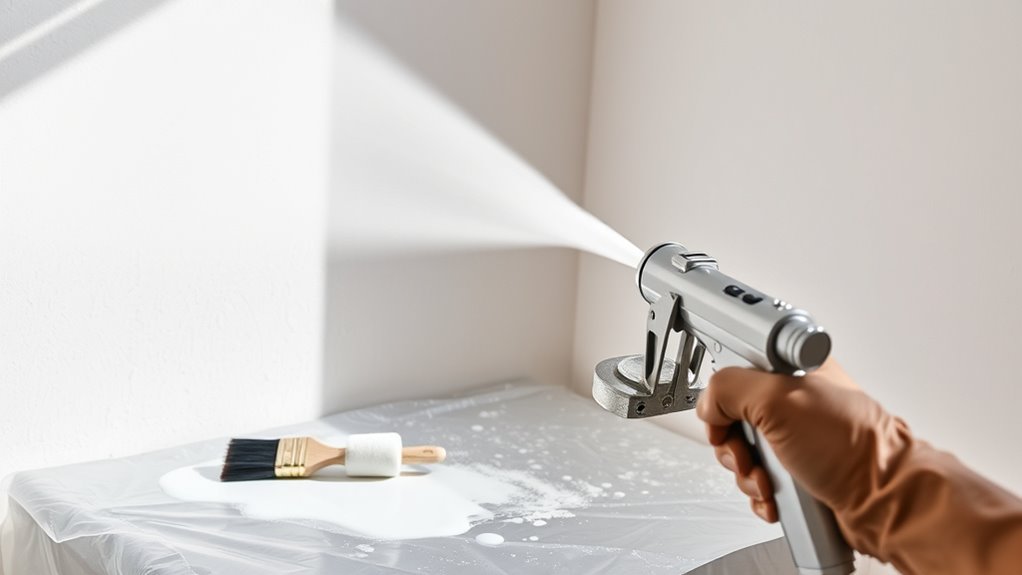
- Paint viscosity: Thinner paint spreads more easily, reducing waste, while thicker paint may require more coats. Using the appropriate headphone jack can ensure optimal audio clarity during application or cleanup processes. Properly managing paint viscosity can also minimize paint waste, leading to cost savings and less environmental impact.
- Surface texture: Rough or textured surfaces absorb more paint, increasing usage compared to smooth surfaces.
- Application method: Sprayers can deliver a consistent coat on textured surfaces but may overspray on smooth surfaces, affecting overall paint consumption.
Efficiency and Waste: Paint Sprayers vs. Traditional Tools
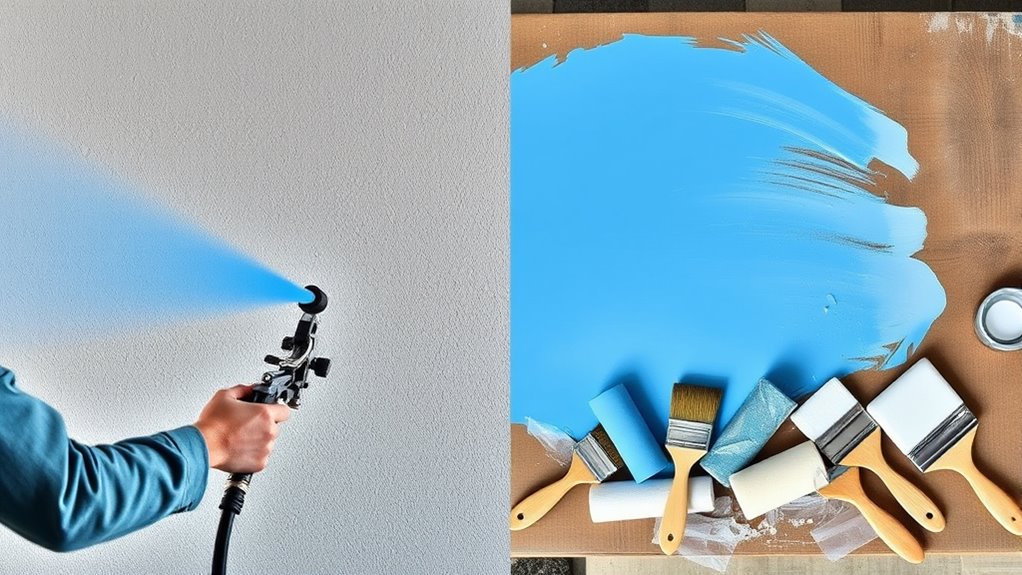
Paint sprayers can cover large areas quickly, saving you time but often generating more overspray. This overspray can lead to extra paint waste if you’re not careful. Additionally, proper paint application techniques can help minimize waste and ensure a smooth, even finish. Comparing this to brushes and rollers, you’ll find that traditional tools may be more precise but slower, affecting overall efficiency and waste. To maximize effectiveness, it’s important to understand decorative techniques that can help reduce waste and improve the quality of your finish.
Coverage Speed Differences
While traditional brushes and rollers often require more time to cover large surfaces, paint sprayers can considerably boost your efficiency thanks to their rapid application. Their coverage speed allows you to complete projects faster and with fewer strokes. Keep in mind, though, that the paint’s thickness and drying times influence overall results. Using a sprayer, you can:
- Cover wide areas in a fraction of the time it takes with brushes or rollers.
- Apply a consistent coat quickly, reducing unevenness.
- Maintain a steady flow that minimizes gaps and touch-up work.
- Honda Tuning techniques and equipment can influence the quality and efficiency of paint application, especially when using sprayers on automotive surfaces. Additionally, understanding paint viscosity helps optimize spray performance and finish quality. Proper paint preparation ensures the best adhesion and smoothness of the final coat. Incorporating proper technique can further enhance application speed and reduce paint wastage, making your project more efficient overall.
Furthermore, selecting the right nozzle size is crucial for achieving optimal spray patterns and coverage.
Overspray and Waste
Have you ever noticed how paint sprayers tend to produce more overspray compared to traditional brushes and rollers? This excess stems from paint vaporization and evaporation during spraying, causing paint to disperse beyond your target surface. Overspray leads to significant waste, as you lose paint that doesn’t stick or dry properly. While sprayers cover quickly, they often require more paint to compensate for evaporation and vaporization losses. This inefficiency can increase overall consumption, making it seem like you’re using more paint. Proper masking and technique help reduce waste, but some overspray is inevitable. Understanding how vaporization and evaporation contribute to overspray allows you to manage waste more effectively, ensuring you don’t spend more paint than necessary. Additionally, Mazda Tuning principles emphasize the importance of precise adjustments, which can be applied to controlling spray techniques for better efficiency. Being aware of paint flow control techniques can further optimize your spraying process and minimize excess waste. Moreover, implementing regular equipment maintenance ensures your sprayer functions optimally, reducing unnecessary overspray caused by malfunction or clogging. Practicing consistent spray technique can also help in controlling the amount of paint used and improving application quality. Staying informed about industry best practices can also help you refine your approach and improve overall efficiency.
Common Mistakes That Lead to Excess Paint Consumption
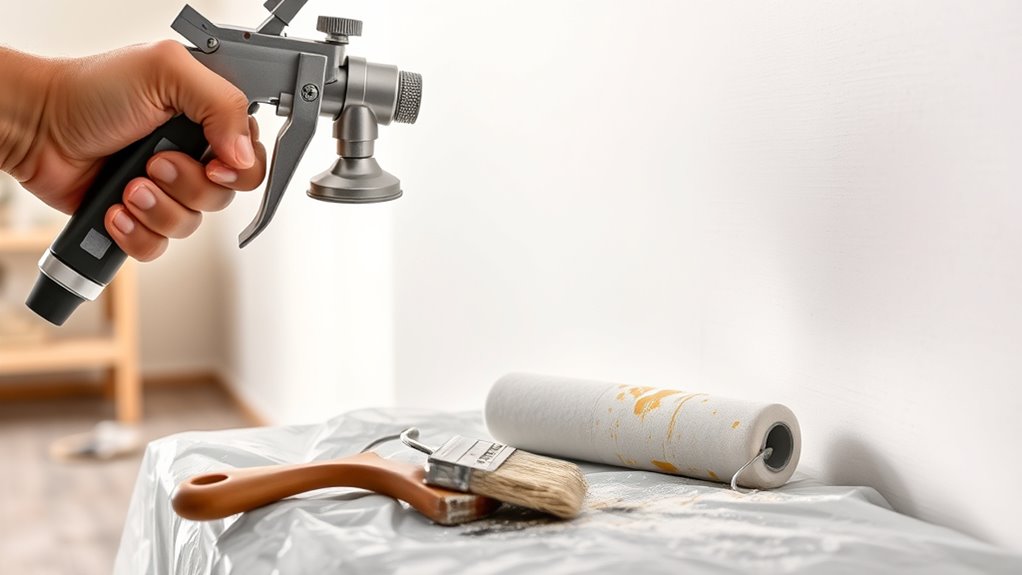
One common mistake is over-application, where you use too much paint and waste material. Another issue is inconsistent surface preparation, which causes you to apply extra coats unnecessarily. Both errors can considerably increase your paint consumption without improving the finish.
Over-application Techniques
Over-application techniques often lead to unnecessary paint waste, and many homeowners fall into common traps without realizing it. Poor brush technique or applying too much roller pressure can cause excess paint buildup. To avoid this, focus on:
- Using a light, consistent brush technique that minimizes drips and overloading.
- Applying just enough paint with your roller, avoiding excessive pressure that causes paint to spread unevenly.
- Releasing excess paint from your roller before applying it to the surface, preventing thick coats.
These habits lead to over-application, wasting paint and requiring extra coats. Proper control of brush and roller techniques helps you use only what’s needed, saving money and reducing mess. Be mindful of your pressure and strokes for efficient, clean painting.
Inconsistent Surface Preparation
Inconsistent surface preparation often causes you to use more paint than necessary because uneven or dirty surfaces require extra coats to achieve a smooth finish. When you skip proper surface preparation, the surface texture varies, leading to uneven absorption of paint. Rough or patchy areas absorb more paint, forcing you to apply additional coats, which increases overall paint consumption. Dirt, grease, or loose particles can cause paint to peel or unevenly spread, wasting material. To avoid this, take time to clean, sand, and prime surfaces before painting. Proper surface preparation guarantees a consistent surface texture, allowing paint to be applied evenly and efficiently. This not only saves paint but also promotes better paint adhesion, resulting in a professional-looking finish with fewer coats. Being aware of surface imperfections can help you identify areas needing extra attention before painting, reducing waste and ensuring a smoother application process. Additionally, understanding surface absorption properties can help you select appropriate primers and paints for optimal coverage, and paying attention to surface condition can further improve the quality and efficiency of your painting project.
Tips for Minimizing Paint Waste With Sprayers, Brushes, and Rollers
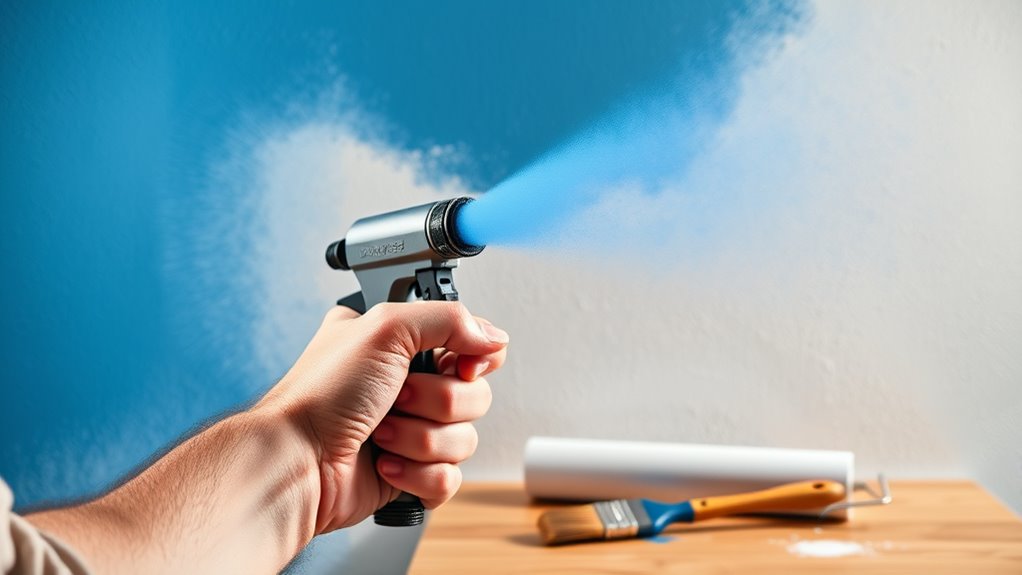
To minimize paint waste when using sprayers, brushes, or rollers, it’s essential to adopt proper techniques and preparation. First, master your brush technique by applying light, even strokes to prevent excess paint buildup. Second, use consistent roller patterns—such as “W” or “M” shapes—to ensure even coverage without over applying paint. Third, prepare your surfaces thoroughly and remove any drips or excess paint from tools before starting. This prevents unnecessary rework and waste. Additionally, keep your tools well-maintained and clean to maximize paint transfer efficiency. By focusing on controlled application methods and surface prep, you’ll reduce paint waste, save money, and achieve a smoother, professional finish with any painting tool. Proper tool maintenance also plays a crucial role in minimizing waste and ensuring efficient paint application.
Making the Right Choice Based on Project Size and Surface Type

Choosing the right painting tools depends heavily on your project’s size and the surface you’re working with. For small, detailed areas, brushes offer precision and better color matching, ensuring clean lines and smooth finishes. Rollers are ideal for larger surfaces, providing quick coverage and consistent paint application. If you’re tackling big projects, sprayers can save time but may use more paint, so plan accordingly. Consider the surface type—rough surfaces benefit from sprayers’ ability to reach crevices, while smooth surfaces might be best with rollers. Additionally, think about paint durability; some surfaces require high-quality paint to withstand wear and weather, influencing your choice of tools and paint type. Matching your tools to the project guarantees a more efficient process and a professional-looking result.
Frequently Asked Questions
Do Paint Sprayers Require More Paint to Achieve the Same Coverage?
When using a paint sprayer, you may find it requires more paint to achieve the same coverage because of paint thickness and nozzle size. A larger nozzle disperses more paint, but if the spray is too thick, you’ll need extra coats. Adjust your nozzle size for better control and efficiency. Ultimately, spray application can use more paint initially, but it offers faster, more even coverage overall.
How Does Paint Type Influence Consumption With Sprayers Versus Brushes?
Ever wonder how paint type influences your project? You might imagine smooth, consistent paint covering a wall effortlessly, but textured surfaces or thick paint can change everything. When using sprayers, thinner paint with good consistency covers quickly, reducing waste. However, rough textures may demand more paint. With brushes, you often control coverage better but may use more paint on textured surfaces. So, your choice depends on paint consistency and surface texture.
Are There Specific Projects Where Sprayers Use Significantly More Paint?
You’ll find that sprayers often use more paint on projects with detailed surfaces or textured walls because they cover more evenly and quickly. For these projects, you might spend extra time on sprayer cleanup afterward, which can lead to slightly more paint use overall. Unlike brush priming, which is more precise, sprayers tend to overspread, especially if you’re aiming for a smooth finish, increasing paint consumption markedly.
Can Improper Technique Lead to Increased Paint Wastage With Sprayers?
Improper technique can definitely lead to increased paint wastage with sprayers. If you don’t calibrate your sprayer correctly, you might apply too much paint or miss areas, reducing application accuracy. This results in excess paint usage and messes. To avoid this, regularly check sprayer calibration and focus on steady, even passes. Mastering proper technique guarantees you use paint efficiently, saving you money and minimizing waste.
Do Environmental Conditions Affect Paint Usage With Different Application Tools?
Imagine a gentle breeze or a scorching sun, and you’ll see how environmental conditions influence your painting. Humidity and wind can cause paint to dry too quickly or drift away, affecting brush efficiency and roller consistency. These factors lead you to use more paint to achieve even coverage. So, yes, weather impacts your tools differently, making it essential to adapt your technique for ideal results and less waste.
Conclusion
In the battle of paint application, sprayers might seem like the paint-hungry giants, gobbling up more than brushes or rollers. But with careful control, you can tame even the wildest sprayer, reducing waste to a mere whisper. Remember, choosing the right tool for your project isn’t just smart—it’s the difference between a masterpiece and a paint disaster. So, pick wisely, and let your project shine without breaking the bank or wasting a drop!
Franz came aboard the Paint Sprayer Zone team with a background in both journalism and home renovation. His articulate writing style, combined with a passion for DIY projects, makes him an invaluable asset. Franz has a knack for breaking down technical jargon into easy-to-understand content, ensuring that even the most novice of readers can grasp the complexities of paint sprayers.
